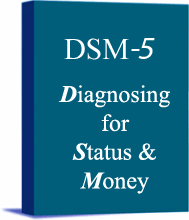
The DSM-5 was born in a new era, with the media and Internet drawing attention to, and forcing, a greater transparency in its development – or actually more clarity about the lack of transparency of the process. There have been massive conflicts and clashes surrounding this process. Not only have mental health professionals engaged more actively in observation and action, but also the general public has become involved and has made its opinions heard. Many believe that the published product is deeply flawed and dangerous in many ways.
The DSM-5 has created new diagnoses and loosened the criteria for certain existing disorders in a way that widens the range of pathology to include what has previously been considered normal behaviors. It is predicted that these changes will result in a higher percentage of people in the general population being inappropriately labeled as mentally ill and unnecessarily medicated, to the tune of billions of dollars in increased profits to the psychopharmacological industry.
Critique of Major DSM-5 Diagnostic Categories
- Disruptive Mood Dysregulation Disorder: Everyone knows children learn to regulate their emotions as they grow. Kids have temper tantrums. We now have a new diagnosis “DMDD” (Disruptive Mood Regulation Disorder”) and many are fearful that normal children will be diagnosed and medicated unnecessarily. This is a huge win for the pharmaceutical companies and will likely be a loss for the brains and nervous systems of many children.
- Grief: Changes in the criteria now make it easier to diagnose a grieving person with Major Depressive Disorder earlier in their grief process. It is likely that, for many, the healing power of a normal grief reaction will be blunted with medication.
- Minor Neurocognitive Disorder: Many with normal age-related minor deficits in cognition will receive this diagnosis, which can be worrisome, and humiliating. The diagnosis is not necessarily predictive of future decline.
- PTSD:There was initial concern by some that the changes would result in, again, pathologizing normal behavior and responses. However, the new criteria are more behavioral and it appears that the DSM-5 will allow diagnosis to be more discrete and specific. This change was partly made in response to the needs of war veterans. There are lowered thresholds for children and adolescents.
- Binge Eating Disorder: The criterion for this “disorder” is “overeating at least once per week for three months”. Imagine the increase in “mental disorder” diagnosis during the period between Halloween candy and New Years celebration leftovers.
- Autism:Many have been concerned that the changes in criteria for Autism in the DSM-5 would disqualify some children from certain educational programs. The issue here is that educational programs should be provided because of educational need rather than diagnosis. The question is why a manual designed for psychiatric diagnosis is even being used as a tool for assessing educational needs.
- Substance Abuse: First time abusers are lumped together with long-term addicts. This confuses treatment issues as well as what is considered wellness or illness and culpability and responsibility.
- Anxiety Disorders: Many are concerned that the “worried well” will be diagnostically labeled and medicated with powerful and addictive anti-anxiety medications.
- There will be many ways in which the new DSM-5 will have legal implications. One sad example involves a single decision made to change a certain criterion from an IQ score to more subjective standards. Inadvertently, this made it more possible for a cognitively impaired, developmentally delayed person to receive the death penalty in some states.
DSM-5 tends to pathologize normal behaviors and temperaments:
As with its predecessors, the new DSM-5 is likely to continue to pathologize normal behaviors in certain especially vulnerable populations, including, but not limited to:
- Girls & Women
- Lower Socio-Economic Class
- Geriatric Populations
- Ethnic Minorities
- Children
- Members of the LGB Community
- Autistic People